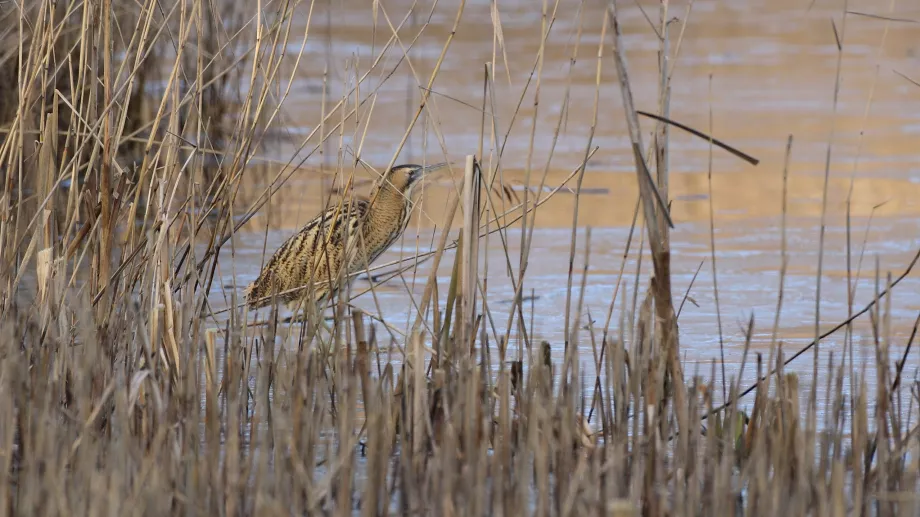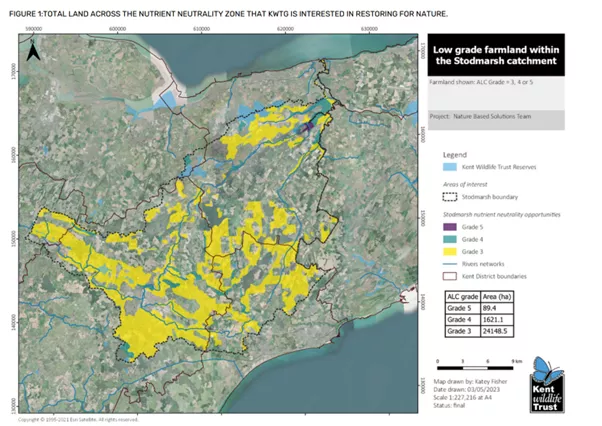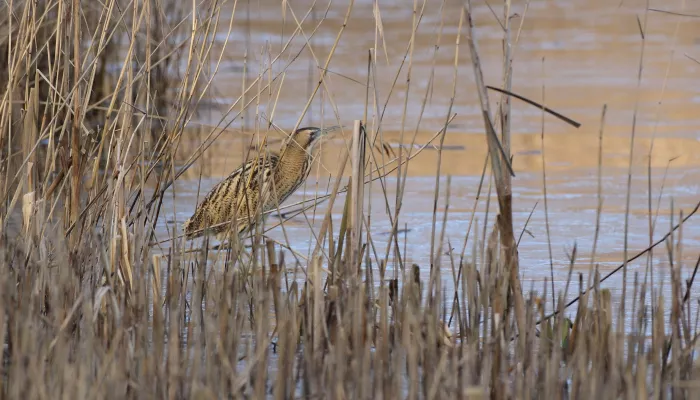
A bittern bird well camouflaged as it walks out of a reedbed ©Tim Stenton. Tim Stenton
Today, many areas in Stodmarsh are classed in unfavourable condition. The lakes are in a state of eutrophication and low oxygen from this has led to fish kill events. Both nitrogen and phosphorous levels have been recorded in excess. Levels of phosphorous were measured at 1000ug/l when the target is just 49ug/l. As more fish and invertebrates begin to die off, less food will be available for the birds to feed on and the value of this reserve for wildlife could be lost.
Excess nitrogen and phosphorous at Stodmarsh Nature Reserve come from:
- wastewater treatment works which outfall upstream of the Stodmarsh,
- runoff from urban and agricultural land,
- flood waters during high and low tidal events
- and the recycling of nutrients from the lakes.
In a 2016 paper by Natural England, wastewater treatment works accounted for 50-80% of the total phosphorous concentration in the river. That river flowing through the Stodmarsh is at the heart of the nature reserve - the Stour. The entire catchment area has been banned from development since 2018 when the European Court of Justice ruled that any additional nutrient loading to SAC and SPA sites that are already in unfavourable condition would not be permissible by law. These developments would have to demonstrate that there would be no ‘Likely Significant Effect’ (LSE) from the development on the downstream designated site.
In 2020, Natural England issued water quality advice stating that an “Appropriate Assessment” must be carried out before permission can be granted for any development that would result in a net increase in population served by a wastewater treatment works including new homes, student and tourist accommodation.
If the Levelling Up and Regeneration Bill (LURB) amendments were allowed to go through, the rules would have been thrown out and developments on the Stour River would have been allowed to continue regardless of the cost to the river and the wildlife it supports. Fortunately the amendments were defeated in the Lords but who knows what the government will do next to force this issue through. The Stour can’t afford any more pressure from increased residential developments.
Nutrient Neutrality Mitigation Scheme
We estimate that to meet the 1250kg total phosphate reduction needed across the Stour catchment, approximately 75,000ha of land needs to be fallowed and taken out of agricultural production. In comparison, Kent County Council currently have a target of constructing approximately 100ha of wetland to offset this phosphate.
Constructing wetlands is expensive, time-consuming and will not be ready for several years yet due to various planning consents and regulations not to mention wetland design, ongoing management and monitoring to ensure offsets.
We believe that there is a way to build new properties AND protect wildlife in the Stour River catchment area. Our nutrient mitigation scheme is more cost effective, easier to implement and will provide mitigation with no lag time. To mitigate the current effects of high nitrogen and phosphorous levels on the River Stour, we’re keen to use our in-house natural capital expertise to deliver Nature-based Solutions.
How does it work?
- We work with developers to buy suitable land off the development site.
- Natural England or the Local Planning Authority work out the nutrient budget for the development.
- We agree the capacity of the site with Natural England and finalise the cost of total nitrate and total phosphate.
- We manage the land for nature and provide additional income streams back to developers through the stacking of natural capital payments such as biodiversity and carbon credits thus supporting the cost of the site purchase and ongoing management and maintenance.
- We monitor and report on the mitigation impact of the measures we’ve taken to help developers meet targets.
With all this low-grade farmland in the Stour River catchment area, there is a huge opportunity for developers to work with Kent Wildlife Trust to mitigate the effects of pollution and improve the area but the impetus must be on the government to enforce nutrient neutrality schemes to speed up the process.

Map showing low grade farmland (much of it Grade 3) in the Stour catchment that can be used in the nutrient mitigation scheme ©Katey Fisher
So, what are we waiting for?
The government’s LURB amendments, even if they haven't passed, send a real signal. We ask the government to reconsider their position and work with deliverers like Kent Wildlife Trust to find a more balanced solution that allows development to continue without risk or damage to nature and wildlife.
You can ask your MP to reconsider their position and work with us too. Please help us Save our Stour.
References
Write to my MP
Hello [MPs name],
I am writing to you with great concern over the recent attempt to amend the Levelling Up and Regeneration Bill. The amendments would have forced competent authorities to ignore scientific advice when approving planning and development projects. Though this attempt was defeated in Lords, it sends a signal that the Conservative party do not believe development companies have a responsibility to mitigate nutrient pollution in our waterways.
The government’s own response to a consultation on Biodiversity Net Gain said it would not “introduce broad exemptions from delivering biodiversity net gain”. By attempting to get through these amendments last minute, the government has shown that it cannot be trusted to uphold its own commitments.
Our River Stour catchment area is already adversely affected by wastewater treatment works which outfall upstream of Stodmarsh Nature Reserve. A 2016 Atkins, Natural England study on Stodmarsh Lake Hydrology found that 50-80% of total phosphorous levels in the river come from wastewater treatment works. We know that new developments will put more pressure on wastewater treatment and without mitigation, the already high concentrations of phosphorous (currently measured at 1000ug/l when the target is 49ug/l) will further impact the wildlife and vegetation that live on the river catchment.
The Stodmarsh is already in poor quality with high eutrophication and fish kill events having been recorded. This SPA, SAC, SSSI and Ramsar site is an important habitat for wildlife, and I am concerned about how increased development would affect it without nutrient neutrality as a mitigation.
Kent Wildlife Trust have proposed a mitigation scheme which involves working with developers to buy land in the catchment and manage the land for nature, providing nutrient mitigation credits for developers and paying for the purchase, management and monitoring of the land through the sale of carbon and BNG credits. I urge you to work with them to find a solution for housing development to continue without adversely affecting the Stour River catchment area and the wildlife that lives there.
Kind Regards,
[your name]

